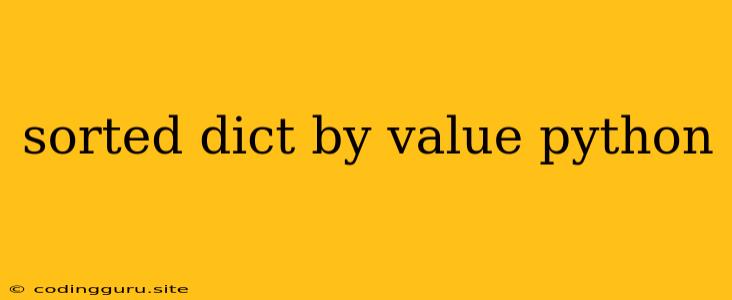Sorting Dictionaries by Values in Python: A Comprehensive Guide
Dictionaries in Python are powerful data structures that store key-value pairs. While they are unordered by default, you might need to sort them based on their values in various scenarios. This guide explores different methods to sort dictionaries by values in Python, providing clear explanations and examples.
Why Sort Dictionaries by Values?
Sorting dictionaries by values is essential for tasks like:
- Displaying data in a specific order: Presenting data in a sorted manner improves readability and allows users to easily understand trends or patterns.
- Filtering or prioritizing items: Sorting by values can help identify the most important or relevant items in a dictionary.
- Performing efficient searches: Organizing data based on values can optimize search algorithms, making it faster to locate specific information.
Methods for Sorting Dictionaries by Values
1. Using sorted with items()
The sorted function in Python is a versatile tool for sorting various data structures. When working with dictionaries, the items() method returns key-value pairs as tuples. We can then sort these tuples based on their values using the key argument in sorted:
my_dict = {'apple': 3, 'banana': 1, 'cherry': 2}
sorted_dict = dict(sorted(my_dict.items(), key=lambda item: item[1]))
print(sorted_dict) # Output: {'banana': 1, 'cherry': 2, 'apple': 3}
In this example, we use a lambda function as the key argument to extract the value (second element) from each tuple. The sorted function sorts these tuples based on the values, and we then convert the sorted tuples back into a dictionary using dict().
2. Using collections.OrderedDict
The collections module in Python provides the OrderedDict class, which remembers the insertion order of its key-value pairs. To sort a dictionary by values, we can create an OrderedDict and insert the key-value pairs in the desired order:
from collections import OrderedDict
my_dict = {'apple': 3, 'banana': 1, 'cherry': 2}
sorted_dict = OrderedDict(sorted(my_dict.items(), key=lambda item: item[1]))
print(sorted_dict) # Output: OrderedDict([('banana', 1), ('cherry', 2), ('apple', 3)])
This method provides a more structured approach to maintaining the order of elements based on values. However, it doesn't modify the original dictionary; instead, it creates a new ordered dictionary.
3. Using a Custom Function for Sorting
For complex sorting scenarios, you can define a custom function to determine the sorting order. This function will take a key-value pair as input and return a value that will be used for comparison:
def sort_by_value(item):
return item[1]
my_dict = {'apple': 3, 'banana': 1, 'cherry': 2}
sorted_dict = dict(sorted(my_dict.items(), key=sort_by_value))
print(sorted_dict) # Output: {'banana': 1, 'cherry': 2, 'apple': 3}
This approach offers flexibility and allows you to implement custom sorting logic according to specific requirements.
Sorting in Descending Order
To sort a dictionary by values in descending order, simply use the reverse parameter in the sorted function:
my_dict = {'apple': 3, 'banana': 1, 'cherry': 2}
sorted_dict = dict(sorted(my_dict.items(), key=lambda item: item[1], reverse=True))
print(sorted_dict) # Output: {'apple': 3, 'cherry': 2, 'banana': 1}
Handling Duplicate Values
When dealing with duplicate values in a dictionary, the sorting order might be unpredictable. To address this, you can define a custom sorting function that takes into account both keys and values:
def sort_by_value_then_key(item):
return (item[1], item[0])
my_dict = {'apple': 3, 'banana': 1, 'cherry': 2, 'mango': 2}
sorted_dict = dict(sorted(my_dict.items(), key=sort_by_value_then_key))
print(sorted_dict) # Output: {'banana': 1, 'cherry': 2, 'mango': 2, 'apple': 3}
Here, the custom function sorts by values first, and then breaks ties by comparing the keys.
Conclusion
Sorting dictionaries by values in Python is a common task with multiple solutions. The most suitable approach depends on your specific requirements, such as the desired order, handling of duplicates, and maintaining the original dictionary. By understanding the various techniques presented here, you can effectively manipulate dictionary data to extract valuable insights and enhance your Python programming skills.
